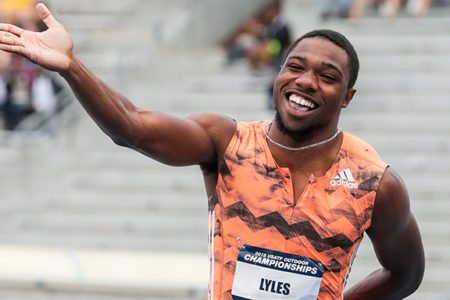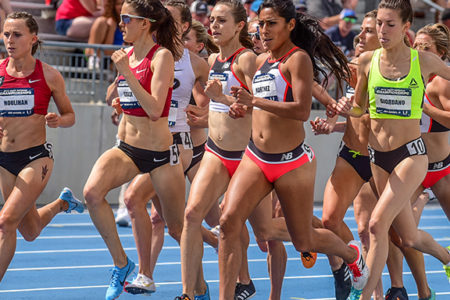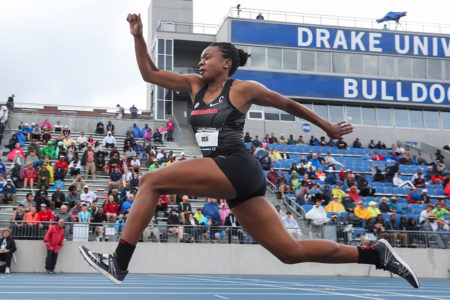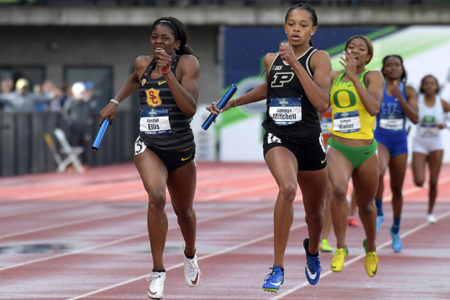
Taking the world lead in the 100 with a PR 9.88 at the USATF Championships put Noah Lyles in a dancing mood under the gray sky above Drake Stadium. And the name of the dance was the… nope, his fancy footwork didn’t have a name.
“It’s a millennial thing,” he says. That and a spontaneous reaction to another milestone surpassed: sub-9.9. Lyles had first breached the barrier with his 9.89 semi to equal Mike Rodgers’ day-old world leader from the heats.
Women’s 100 winner Aleia Hobbs told journalists in the mixed zone she thought she could give Lyles a run for his money in a dance-off, and suggested she might retire to her hotel room to practice for the challenge, but no one finished ahead of Lyles on the track.
Just over 11 months into his 21st year, and one lap around the sun since a hamstring strain forced him to withdraw from his ’17 USATF 200 semi, the Virginia native had made himself the candidate du jour to step into the enormous sprint-doubling void left by Usain Bolt.
While Lyles hasn’t yet cemented his claim to the heir’s spot—the other contenders are well known—his Des Moines dash bestowed a new descriptor for the first time: world class century threat. Noah Lyles, ’17 Diamond League 200 titlist, is now Noah Lyles all-purpose dashman.
Interviewed last fall for our ’18 Super Preview issue, Lyles said, “I feel like I have a lot more to give and with the program I’m in with Coach Lance Brauman, I feel like we can definitely reach that potential.” He’s off to a super start on the project, with exhibits including his 19.69 Pre 200 win over the ’17 WC gold and bronze medalists.
Said Brauman after that outing, “He actually executed the start and then he ran the first part of the turn, which is what he’s been working on, and then did a real good job transitioning off and holding it home. That time’s pretty quick, to be honest with you. I mean I was pleased with the 19.8 [Lyles’ then-PR 19.83 in Doha] a couple weeks ago and figured it would just be a gradual decline [toward faster times] from there. But it was a good field, conditions were great, and you know when the conditions are that way you have a chance to run fast and he took advantage of it.”
Between the Pre Classic and Des Moines, Brauman said, would come a 100 test in Kingston: “He’s gonna set it up and run his best. I think he can be a 9.9, 9.8 guy so that’s what he’s working towards.” Lyles was already a 9.8 guy, sorta, one with a powerful wind (4.1mps) behind the 9.86 he ran in Gainesville in April. At the Racers GP meet in Kingston (June 9), Lyles sprinted 9.93, placing 2nd to the 9.91 PR of long, tall Briton Zharnel Hughes.
In Des Moines he won the blue riband sprint with the race model of a veteran, the type that often carried Carl Lewis across the line in front three decades ago and made Justin Gatlin a world 100 champion for the second time at age 35 last year. Lyles used the entire straight and strode past PRing Ronnie Baker, the preeminent century man on the ’18 DL circuit, just before the line. His was a patient win. (Continues)
“Patience is kind of the thing I’m kind of big on,” he says. “I feel that if you’re pushing for something, it’s a little harder, you’re straining and you might get taken out of your own race so I knew that if I just kept focused I could do what my body was going to allow me to do. If it didn’t happen, it didn’t happen and I knew that I gave 100% either way.”
In other words, applying a 200 approach to the shorter sprint? Not as Lyles saw it. “I don’t think it was so much of a 200 thing,” he says. “I think it was just trying to get out and be a competitor—just try to be great, be up there with everybody else, you know? That [9.89] gave a lot of motivation to me and I was telling my coach, ‘I’m trying to keep all my excitement in so I don’t go crazy out there in the cool-down area.’
“But I was just trying to hold it in until the finals and I just let it all go. My coach said, ‘I’m giving you the all clear to go all out,’ and I said, ‘It’s on!’ ”
His millennial dance party of one, and a bow to the crowd, was powered, too, by a release of frustration Lyles carried through the winter when he raced four 60s, including a USATF Indoor heat and semi, without winning a race.
“I was just getting my butt kicked day after day in the 60,” he says, “and every week I’m seeing the same guys and I’m just getting my butt kicked and I’m just, ‘This is hard!’ It’s hard to take an ‘L,’ you know? And it’s hard when you know that you’re better but you’re not running your own event. All I kept saying in my head was, ‘Getting ready for outdoor, getting ready for outdoor, getting ready for outdoor.’
“So finally outdoor comes and my times are just dropping, everything’s going well, and I’m like, ‘Alright, we need to really test this. I need to jump in a 100.’ Coming out here just proved that all that persistent nature of just trying to work on my start and running the 60s was really paying off.”
Lyles has successfully flipped the switch. “I believe it came after Doha,” he says, “and right after Boston”—the adidas Boost street meet, where Lyles ran down LSU alum Nethaneel Mitchell-Blake in the last 30m of a straightaway 150, timed in 14.77.
“We went back and I did a few starts, and all of a sudden I felt like it was just clicking. I know I didn’t get the greatest start at Boston but I still felt like my starts were [snaps his fingers] clicking. And my transition was going together and it proved right [at Pre]. Then we went to Jamaica and that just really solidified it for me.” Beyond just physically grooving his race skills, “it” was also belief in what those skills could yield.
Lyles says of his chase after Baker for the first 95-odd meters of the USATF final, “If I would have tried to push I would have jumped out of my whole frame, I would have jumped out of my positions, something would have tried to go faster and pulled on something else. I feel that if you let your body do what it does naturally, it’ll hit, and if it doesn’t hit it wasn’t time.”
The time where Lyles wants it to hit next year will be in late-September/early October at the World Championships in Doha.
After attacking the second half of this summer’s Diamond League season starting, he hopes, by making some noise in the Lausanne 200 on July 5, Lyles and Brauman plan an adjusted build-up for what Lyles calls “the looong, looong next year.” Phase one of fall training will be conducted Yogi style. “I’m thinking of just acting like a bear and just having a hibernation, a good old-fashioned sleep,” he says.
“Me and my coach have talked about it with the group [the members of which include among others brother Josephus (6th in the USATF 400), and two women’s 400 stars, USATF winner Shakima Wimbley and Olympic gold medalist Shaunae Miller-Uibo]. We’re probably going to take a lot of jogging during a lot of the months. We’re probably not going to do any indoor, we’re probably just going to keep our rest because the season is so far down there. Especially since after you have that long season, you gotta go straight into the Olympics, so we’re probably just going to keep it low.”
Following, of course, a new high in the 100.






